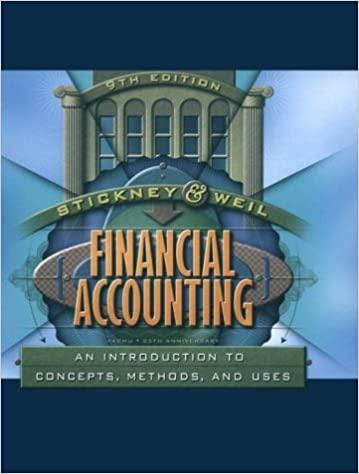Identifying generally accepted accounting principles. Indicate the generally accepted accounting principle or method described in each of
Question:
Identifying generally accepted accounting principles. Indicate the generally accepted accounting principle or method described in each of the following statements.
Explain your reasoning.
a. This inventory cost flow assumption results in reporting the largest net income during periods of rising prices.
b. This method of accounting for uncollectible accounts recognizes the implied income reduction in the period of sale.
c. This method of accounting for long-term investments in the securities of other corporations usually requires an adjustment to net income to calculate cash flow from operations in the statement of cash flows.
d. This method of accounting for long-term lea.ses by the lessee gives rise to a noncurrent liability.
e. This inventory cost flow assumption results in approximately the same balance sheet amount as is produced under the FIFO flow assumption.
f. This method of recognizing interest expen.se on bonds provides a uniform annual rate of interest expense over the life of the bond.
g. During periods of rising prices, this inventory valuation basis produces approximately the same results as does the acquisition cost valuation basis.
h. When a firm deems specific customers" accounts uncollectible and writes them off, this method of accounting results in a decrease in the current ratio.
i. This method of depreciation generally provides the largest amounts of depreciation expen.se during the first several years of an as.set's life.
j. This method of accounting for intercorporate investments in securities can result in a decrease in the investor's total shareholders' equity without affecting the Retained Earnings account.
k. This method of recognizing income from long-term contracts generally results in the least amount of fluctuation in earnings over several periods.
1. When a firm identifies specific customers" accounts as uncollectible and writes them off, this method of accounting results in no change in working capital (equals current assets minus current liabilities).
m. When a firm uses this inventory cost flow assumption in calculating taxable income, it generally must use it in calculating net income reported to shareholders.
n. This method of accounting for long-term leases of equipment by the lessor shows on the income statement an amount for depreciation expense.
o. This inventory cost flow assumption results in inventory balance sheet amounts closest to current replacement cost.
p. This method of accounting for long-term investments in securities results in recognizing revenue for dividends received or receivable.
q. This method of depreciation generally results in the largest amounts for depreciable assets on the balance sheet during the first several years of an asset's life.
r. This inventory cost flow assumption results in reporting the smallest net income during periods of falling prices.
s. The method of accounting for long-term leases of equipment by the lessee results in showing an amount for rent expense on the income statement.
t. This inventory cost flow assumption results in inventory balance sheet amounts that may differ significantly from cunent replacement cost.
u. This method of accounting for long-term leases of equipment by the lessor results in showing revenue at the time of signing a lease.
V. This inventory cost flow assumption can result in substantial changes in the relation between cost of goods sold and sales if inventory quantities decrease during a period.(Appendix)
Step by Step Answer:

Financial Accounting An Introduction To Concepts Methods And Uses
ISBN: 9780030259623
9th Edition
Authors: Clyde P. Stickney, Roman L. Weil





